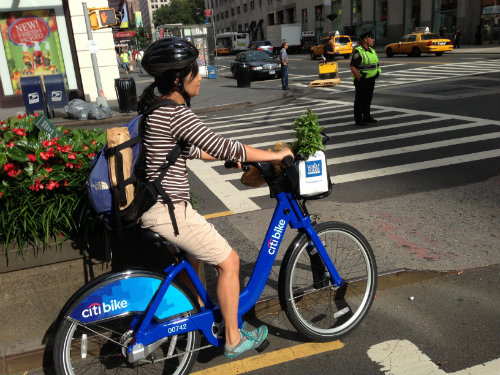(This is the second in a series of lessons from this car-free Angeleno who found himself in NYC for a year. Read the introductory installment here.)
There's a plannerspeak term: "first mile / last mile." It generally refers to how to get folks to transit stops from actual destinations including home, work, stores, restaurants, and the like. Transit doesn't offer point-to-point service (like walking, bicycling and driving), so there's usually some other mode attached to the start and/or end of each transit trip. Most often it's walking, but there's also bicycling, shuttles, taxis, and more. Big transportation agencies including Metro and SCAG employ consultants to study and report on the first mile / last mile; see their results here and here. It's a great issue to tackle. Streetsblog reports on the first mile / last mile every day, though we don't use that terminology all that often.
Mayor Garcetti is pressing for a Los Angeles County-wide bike share system to be spearheaded by Metro. I am all for bike share, and the bigger the better... but... I've been thinking that there are some potential pitfalls.
Bike share, even at its densest concentrations, doesn't quite offer point-to-point service. Which is to say that bike share potentially has a "first mile / last mile" problem... but it's more like a "first couple blocks / last couple blocks" problem. Bike share trips start and end on foot, so the solution to the bike share first/last problem is walkability.
I've been enjoying riding NYC's Citibike bike share system. In lower Manhattan it seems like there are stations and bikes every few blocks. It's difficult to walk a half-dozen blocks without coming across one.
I've taken dozens of trips on Citibike. The bikes generally get me closer to my destination than the NYC subway, which is quite an accomplishment, given the extensive subway system. But each trip still ends with walking, using at least a couple blocks.

In case you're unfamiliar with bike share, there's no bike lock. You pick up your bike at a rental station, and you return it to a station. If you're, for example, running an errand, say buying a book, you can't easily run into a bookstore leaving your bike outside. For bike share to be useful, there needs to be two stations: one near the start of your trip and one near your destination. Since there won't be a station in front of every home and every job site, there will be some walking. You'll need a convenient, safe sidewalk to walk those last few blocks between your station and your destination.
So, based on my experience, here's some advice for a Los Angeles county-wide bike share system:
1. Foster multi-modal connections: Bike share and transit dovetail really well. Transit riders disembark their train or bus, and hop on a bicycle to get them close to their destination. With Metro as the parent agency for bike share, it should be straightforward to make space available at Metro rail stations. Convenient bikes located at Metro stations help Metro solve its first mile / last mile issues. Not all Metro stations are equal, though - see below.
2. Focus the system into selected areas: With political interests to be served, there may be a temptation to spread the system out - to pepper a few bike rental stations into every Metro boardmember's jurisdiction. Without a density of stations in a locale, bike share is unlikely to serve many trips. If we put, say, five bike share stations near every Metro rail station throughout L.A. County, I expect that we wouldn't get a critical mass of stations anywhere. Bike share would fail to be useful. If we instead select 3-5 areas and cluster large numbers of bike share stations throughout each area - say 30+ stations in each area - then bike share can be useful and successful, and likely to spread from there. Perhaps there can be some sort of competition with areas competing with each other to be selected for initial bike share implementation.
3. Focus on walkability: Ideally, this means that if we want county-wide bike share, then we make all of Los Angeles County a great place to walk! Maybe I should end there. Actually, though, the near-term walkability solution would be to focus bike share in areas that already have plenty of pedestrians. This means places like MacArthur Park, Koreatown, Hollywood and downtowns including Los Angeles, Pasadena, Santa Monica and Long Beach.
I am looking forward to bike share in Los Angeles. I think it's going to get me walk more!







